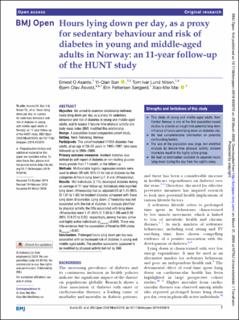| dc.contributor.author | Asante, Ernest O | |
| dc.contributor.author | Sun, Yi-Qian | |
| dc.contributor.author | Nilsen, Tom Ivar Lund | |
| dc.contributor.author | Åsvold, Bjørn Olav | |
| dc.contributor.author | Sørgjerd, Elin Pettersen | |
| dc.contributor.author | Mai, Xiao-Mei | |
| dc.date.accessioned | 2020-03-31T07:43:36Z | |
| dc.date.available | 2020-03-31T07:43:36Z | |
| dc.date.created | 2020-03-30T11:55:02Z | |
| dc.date.issued | 2020 | |
| dc.identifier.citation | BMJ Open.2019, 10 (3) | en_US |
| dc.identifier.issn | 2044-6055 | |
| dc.identifier.uri | https://hdl.handle.net/11250/2649560 | |
| dc.description.abstract | Objective We aimed to examine relationship between hours lying down per day, as a proxy for sedentary behaviour and risk of diabetes in young and middle-aged adults, and to assess if leisure-time physical activity and body mass index (BMI) modified this relationship.
Design A population-based prospective cohort study.
Setting Nord-Trøndelag, Norway.
Participants The cohort included 17 058 diabetes-free adults, at an age of 20–55 years in 1995–1997, who were followed-up to 2006–2008.
Primary outcome measures Incident diabetes was defined by self-report of diabetes or non-fasting glucose levels greater than 11 mmol/L at the follow-up.
Methods Multivariable logistic regression models were used to obtain OR with 95% CI for risk of diabetes by the categories of hours lying down (≤7, 8 and ≥9 hours/day).
Results 362 individuals (2.1%) developed diabetes during an average of 11-year follow-up. Individuals who reported lying down ≥9 hours/day had an adjusted OR of 1.35 (95% CI 1.01 to 1.80) for incident diabetes compared with those lying down 8 hours/day. Lying down ≤7 hours/day was not associated with the risk of diabetes. In analysis stratified by physical activity, the ORs associated with lying down ≥9 hours/day were 1.41 (95% CI 1.05 to 1.90) and 0.90 (95% CI 0.23 to 3.55), respectively, among the less active and highly active individuals (pinteraction=0.048). There was little evidence that the association differed by BMI status (pinteraction=0.62).
Conclusions Prolonged hours lying down per day was associated with an increased risk of diabetes in young and middle-aged adults. The positive association appeared to be modified by physical activity but not by BMI. | en_US |
| dc.language.iso | eng | en_US |
| dc.publisher | BMJ Journals | en_US |
| dc.rights | Navngivelse-Ikkekommersiell 4.0 Internasjonal | * |
| dc.rights.uri | http://creativecommons.org/licenses/by-nc/4.0/deed.no | * |
| dc.title | Hours lying down per day, as a proxy for sedentary behaviour and risk of diabetes in young and middle-aged adults in Norway: an 11-year follow-up of the HUNT study | en_US |
| dc.type | Peer reviewed | en_US |
| dc.type | Journal article | en_US |
| dc.description.version | publishedVersion | en_US |
| dc.source.volume | 10 | en_US |
| dc.source.journal | BMJ Open | en_US |
| dc.source.issue | 3 | en_US |
| dc.identifier.doi | 10.1136/bmjopen-2019-035010 | |
| dc.identifier.cristin | 1804233 | |
| dc.description.localcode | This is an open access article distributed in accordance with the Creative Commons Attribution Non Commercial (CC BY-NC 4.0) license, which permits others to distribute, remix, adapt, build upon this work non-commercially, and license their derivative works on different terms, provided the original work is properly cited, appropriate credit is given, any changes made indicated, and the use is non-commercial. See: http://creativecommons.org/licenses/by-nc/4.0/. | en_US |
| cristin.ispublished | true | |
| cristin.fulltext | postprint | |
| cristin.qualitycode | 1 | |

